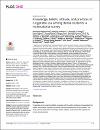Knowledge, beliefs, attitude, and practices of E-cigarette use among dental students: A multinational survey

View/
Date
2022-10-27Author
Alhajj, Mohammed NasserAl-Maweri, Sadeq Ali
Folayan, Morenike O
Halboub, Esam
Khader, Yousef
Omar, Ridwaan
Amran, Abdullah G
Al-Batayneh, Ola B
Celebić, Asja
Persic, Sanja
Kocaelli, Humeyra
Suleyman, Firas
Alkheraif, Abdulaziz A
Divakar, Darshan D
Mufadhal, Abdulbaset A
Al-Wesabi, Mohammed A
Alhajj, Wadhah A
Aldumaini, Mokhtar A
Khan, Saadika
Al-Dhelai, Thiyezen A
Alqahtani, Ahmed Shaher
Murad, Ali H
Makzoumé, Joseph E
Kohli, Shivani
Ziyad, Tareq A
...show more authors ...show less authors
Metadata
Show full item recordAbstract
E-cigarette use is a trend worldwide nowadays with mounting evidence on associated morbidities and mortality. Dentists can modify the smoking behaviors of their patients. This study aimed to explore the knowledge, beliefs, attitude, and practice of E-cigarette use among dental students. This multinational, cross-sectional, questionnaire-based study recruited undergraduate dental students from 20 dental schools in 11 countries. The outcome variable was current smoking status (non-smoker, E-cigarette user only, tobacco cigarette smoker only, dual user). The explanatory variables were country of residence, sex, age, marital status, and educational level. Multiple linear regression analysis was performed to explore the explanatory variables associated with E-cigarette smoking. Of the 5697 study participants, 5156 (90.8%) had heard about E-cigarette, and social media was the most reported source of information for 33.2% of the participants. For the 5676 current users of E-cigarette and/or tobacco smoking, 4.5% use E-cigarette, and 4.6% were dual users. There were significant associations between knowledge and country (P< 0.05), educational level (B = 0.12; 95% CI: 0.02, 0.21; P = 0.016) and smoking status (P< 0.05). The country of residence (P< 0.05) and smoking status (P< 0.05) were the only statistically significant factors associated with current smoking status. Similarly, there were statistically significant associations between attitude and country (P< 0.05 for one country only compared to the reference) and history of previous E-cigarette exposure (B = -0.52; 95% CI: -0.91, -0.13; P = 0.009). Also, the practice of E-cigarettes was significantly associated with country (P< 0.05 for two countries only compared to the reference) and gender (B = -0.33; 95% CI: -0.52, -0.13; P = 0.001). The knowledge of dental students about E-cigarette was unsatisfactory, yet their beliefs and attitudes were acceptable. Topics about E-cigarette should be implemented in the dental curriculum.
Collections
- Dental Medicine Research [396 items ]

